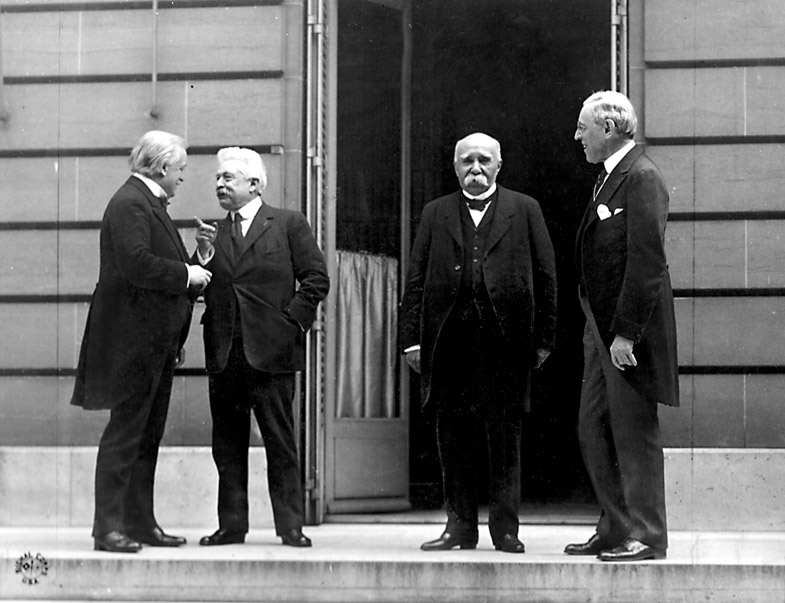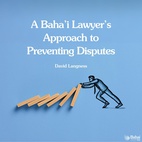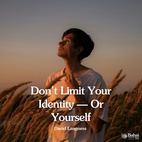The views expressed in our content reflect individual perspectives and do not represent the official views of the Baha'i Faith.
How do we define who we are?
Tribes isolated by distance, language and culture, who have limited interaction with other tribes, probably find it easier to experience safety and comfort in their identity. However, the human experience has always involved the migration of peoples. Eventually, this leads to a rich but complex human culture, where the perceived differences between us can lead people to fragment themselves into ever smaller groups who live in proximity to one another, but rarely mix.

“The Big Four” at the Paris Peace Conference (from left to right, David Lloyd George of Britain, Vittorio Emanuele Orlando of Italy, Georges Clemenceau of France, Woodrow Wilson of the U.S.)
This stark reality exploded during the 1919 Paris Peace Conference after World War I. With the defeat of Germany and the Austro-Hungarian Empire, the victorious Allied powers redrew national borders, dissolved empires and created new countries. This not only had ramifications for Europe but for the Middle East and Africa as well.
On every continent the Paris treaties touched, and everywhere they attempted to create coherent new nationalistic states with separate ethnic or language-based groups, the expulsion and extermination of minorities followed. Far from promoting an actual peace, the treaties sowed the seeds of World War II.
After the preceding centuries of fractured kingdoms and empires, religious conquest and conversion, plus co-mingling of ethnicities and races, what human considerations do you make when you redraw the map of the world? Self-identification emerged as a huge problem. There were areas where the cities and countrysides had different ethnicities; where the same ethnicities had different Faith traditions; where the same ethnicities had fallen under different rule and thus had different national identities. There were people who had a similar language and literature, but had no political connection. This witches’ brew of ancient historical forces all mixed with tribal, ethnic, racial, religious, political and national identifications, and an ugly, unhealthy dose of ingrained hatred and prejudice.
Although the ability to have large populations of a reassuring, undiluted human identity had largely disappeared, there remained the illusion that it could be achieved. In redrawing the maps, however, all efforts to neatly group people together in enclaves not only failed, but left festering resentments that helped lead us into World War II. The Paris Peace Conference and resultant Treaties are often blamed for this. However, they were really only a reflection of the mindset of the time. Could there have been a different outcome? Can we imagine one today?
Baha’u’llah, in the 19th century, answered yes. He not only diagnosed the malady, but provided the remedy:
Witness how the world is being afflicted with a fresh calamity every day. Its tribulation is continually deepening… At one time it hath been agitated by contentions and disputes, at another it hath been convulsed by wars, and fallen a victim to inveterate diseases. Its sickness is approaching the stage of utter hopelessness… – Gleanings From The Writings of Baha’u’llah, p. 39.
Arise and, armed with the power of Faith, shatter to pieces the gods of your vain imaginings, the sowers of dissension amongst you. Cleave unto that which draweth you together and uniteth you. – Ibid., p. 217.
Then, as now, to build unity and a lasting peace requires humanity to embrace a new identity: world citizen. Because this still eludes us, we remain captives of the past. What we see in the news today—the Balkan wars, Syria, the Kurdish question, Middle Eastern and African conflicts—really represent ancient issues and rivalries dressed in a modern guise. Our stubborn refusal to embrace the oneness of humanity tragically demands the continuing sacrifice of millions on the altar of war, ethnic hatreds, nationalism and “the gods of… vain imaginings.”
Recycled political solutions and eroding paradigms only provoke chaos. Powerless to prevent a collapsing old nationalistic system of sovereign rivalries, they continually produce conflict, prejudice and war. However, Baha’is believe that Baha’u’llah has provided a template of a new world order, to free us from the dogma of the past and bring salvation for our future:
O ye that dwell on earth! The distinguishing feature that marketh the preeminent character of this Supreme Revelation consisteth in that We have, on the one hand, blotted out from the pages of God’s holy Book whatsoever hath been the cause of strife, of malice and mischief amongst the children of men, and have, on the other, laid down the essential prerequisites of concord, of understanding, of complete and enduring unity. – Ibid., p. 97.
Baha’u’llah promised “The Most Great Peace” would eventually come to the world—but the human cost extracted in getting there will be up to us. It will require the adoption of Baha’u’llah’s spiritual solutions rather than those which spring from human capacity alone. His teachings can generate the unity that can answer the cries of a groaning humanity.
Can our future have a different outcome? The answer today is the same as it was in 1919 – YES! However, we must redeem the promise of world peace for ourselves:
How glorious the spectacle of real unity among mankind! How conducive to peace, confidence and happiness if races and nations were united in fellowship and accord! The Prophets of God were sent into the world upon this mission of unity and agreement: that these long-separated sheep might flock together. When the sheep separate, they are exposed to danger, but in a flock and under protection of the shepherd they are safe from the attack of all ferocious enemies. – Abdu’l-Baha, The Promulgation of Universal Peace, p. 57.

















Comments
Sign in or create an account
Continue with Facebookor